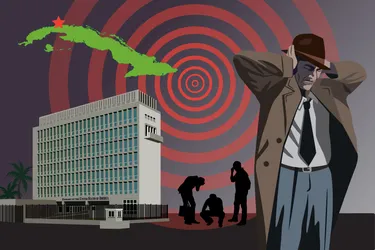By Paul Rogers
In 2016, CIA officers in Havana, Cuba, started having unexplained health issues. They reported a persistent piercing sound followed by symptoms including headaches, nausea, vertigo, trouble concentrating, and memory loss. Was it a new condition? Or was it the latest incidence of the centuries-old phenomenon of mass psychogenic illness, formerly called mass hysteria?
Since 2016, hundreds of incidents of what is now dubbed “Havana syndrome” have been recorded by U.S. intelligence and Foreign Service personnel in a growing list of global locations, including Russia and China. As most were working in hotbeds of espionage, surrounded by traditional U.S adversaries, many in the American government and media soon began to suspect foul play.
Others are skeptical, theorizing that mass psychogenic illness (MPI) is really behind Havana syndrome. “Mass hysteria is an outbreak of a physical illness in a group that appears to have an organic or physiological cause, but actually stems from psychological causes, often from anxiety,” says Gary Small, MD, professor of psychiatry at UCLA.
The question is far from settled. But MPI is not a new phenomenon; examples pop up throughout history. And while the symptoms, patients, and locations differ, some trends hold steady: these illnesses are often born of stress, and they spread like wildfire among close social networks. No two “epidemics” are exactly alike, but history may shed some light on the present murky situation: If Havana syndrome is another MPI, how does it compare to MPIs in the past? Can historical instances of mass psychogenic illness contribute to a better understanding of this elusive medical enigma?
MPI has been recognized since the Middle Ages. Dancing mania was first reported in 7th-century Europe and reappeared across that continent until the 17th century, comprising huge crowds dancing erratically for sometimes days at a time. A notable 1518 outbreak began with the feverish cavorting of a lone woman in the streets of Strasbourg in modern-day France. Theories as to why groups of up to 400 people followed suit include stress-induced psychosis resulting from widespread disease and famine in the region.
The infamous Salem, MA, witch trials of 1692-1693 were a response to numerous girls having outlandish, inexplicable fits. The cause of these convulsions and their interpretation as evidence of witchcraft are still debated. But collective tension resulting from recent epidemics and posttraumatic stress disorder from the ongoing King William’s War, from which many of the affected girls were refugees, have been cited as factors.
“You tend to see patterns,” says Small. “People affected often are in isolated situations. There’s some kind of stress that the group is experiencing without any means of resolving it.”
The 1962 Tanganyika laughter epidemic began at a mission-run girls’ boarding school in Kashasha, Tanzania. Starting with three students, fits of laughter lasting up to several days spread throughout the school, forcing its closure. The epidemic then spread to a village to which several students had returned.
Small co-authored a study of a 1979 incident at a Boston elementary school when, while performing in an end-of-year play, an influential boy became dizzy and fell, bleeding profusely. This triggered psychogenic responses including dizziness, hyperventilation, and abdominal pain in one-third of the student body.
“There are a number of psychological stressors among those kids, let alone just the performance anxiety they’re experiencing,” says Small, whose findings suggested a relationship between childhood loss, such as parental divorce or family death, and susceptibility to MPI.
In 1983, an outbreak of mass fainting and nausea affected 943 Palestinian girls and a few female Israeli soldiers in the occupied West Bank. Israel and Palestine traded allegations of chemical warfare, but ultimately a local health official concluded that while the first 20% of cases were probably caused by an unidentified gas, the remainder were essentially psychosomatic, according to Time magazine.
A UCLA investigation of a 1989 incident in which 247 student performers, most of them female, became violently ill at Santa Monica Civic Auditorium similarly noted that children who saw a friend become sick were the most likely to develop symptoms, which were thus transmitted through social networks.
Hundreds of girls at a boarding school near Mexico City experienced unexplained leg pain, nausea, and fever during 2006-2007. It was a closed community, with students denied access to television or radio. The resulting almost familial bonds between them may have contributed to what psychiatrist Nashyiela Loa Zavala, who investigated the case, has termed the “audiovisual contagion” of MPI.
Commonalities exist between at least some Havana syndrome cases and historical MPI outbreaks. MPI usually begins among a small, cohesive group of people of higher status, in a stressful situation, and then spreads.
“The involvement of four [CIA agents] from the same station is a defining feature of mass psychogenic illness, which is known to follow social networks,” says New Zealand-based medical sociologist Robert Bartholomew, PhD.
Most Havana syndrome cases are personnel isolated far from home in overseas embassies, not unlike the boarding students involved in many MPI outbreaks. They are bonded by a stressful work environment, under constant surveillance, and likely cognizant of Russia’s alleged prior use of microwave transmissions to disrupt U.S. intelligence. Yet for reasons of national security, they are typically unable to share related anxieties with family or “civilian” friends.
Some symptoms previously attributed to MPI, including headache, dizziness, and nausea, have been associated with Havana syndrome. Bartholomew suggested that “reframing” of these common complaints by those affected, to reflect what doctors and government authorities are telling them, could contribute to the phenomenon. In other words, people might be experiencing generic symptoms common in MPI and be susceptible to sinister explanations — without any evidence for them.
Havana syndrome outbreaks are separated by sometimes thousands of miles, which ostensibly eliminates audiovisual contagion. But the internet has redefined the concept of “community” to now transcend geographical proximity. Social media and online news undoubtedly made U.S. diplomats and intelligence officers well aware of graphic descriptions of Havana syndrome symptoms from peers around the world, some of whom would be personally known to them from prior postings.
However, Havana syndrome does not meet all common MPI criteria. Small noted “a preponderance of symptoms [of MPI] in girls or women compared with boys or men.” Indeed, MPI disproportionately affects young girls more than any other demographic. Yet the majority of Havana syndrome cases have been middle-aged men.
There is no consensus on the cause of Havana syndrome. Theories range from the mating call of crickets to a sonic weapon. Some experts maintain that early cases of Havana syndrome present unambiguous evidence of neurological damage consistent with exposure to microwave radiation. Yet they remain open to contributing psychosocial factors in at least some instances.
“We found [microwave radiation] to be most plausible in explaining a subset of the cases, not all cases,” says David Relman, MD, a Stanford University microbiologist who headed the National Academy of Sciences study of Havana syndrome. Relman said that this subset comprised staff of the American embassy in Cuba and at the U.S. consulate in Guangzhou, China, which was the second location to report symptoms.
James Giordano, PhD, professor of neurology at Georgetown University and advisor to the Pentagon, said that the original cases at the Havana embassy “had objective features — clinically relatable, objectifiable, and valid and evidentiary signs — that were indicative of some form of neurological trauma or insult.” But he noted that only a fraction of the worldwide incidents to date have been verified as meeting the full, objective clinical criteria for the type of anomalous health incident known as Havana syndrome.
After 5 years, hundreds of cases on multiple continents, and continuous, inconclusive investigation, there may never be a definitive answer to whether Havana syndrome is physical or psychogenic. But history may bring more clarity than Cold-War-era spycraft. Havana syndrome has some major differences from MPI epidemics of the past, but in many ways it’s more similar than not — and paranoia in the American intelligence community would hardly be unprecedented.
Paul Rogers is a British-born journalist based in Los Angeles. A graduate of the School of African and Asian Studies at the University of Sussex, his work has appeared in the Los Angeles Times, National Geographic Traveler, LA Weekly, and many others.


































